|
|
 |
Fiche d'espèce de Copépode |
|
|
Calanoida ( Ordre ) |
|
|
|
Calanoidea ( Superfamille ) |
|
|
|
Calanidae ( Famille ) |
|
|
|
Neocalanus ( Genre ) |
|
|
| |
Neocalanus tonsus (Brady, 1883) (F,M) | |
| | | | | | | Syn.: | Calanus tonsus Brady, 1883 (p.34, figs.F); Giesbrecht, 1892 (p.92); Giesbrecht & Schmeil, 1898 (p.19); Wolfenden, 1908 (p.11, figs.F); Farran, 1929 (p.207, 216, fig.F); Wilson, 1932 a (p.20, fig.F); Campbell, 1934 (p.1, life history); Wilson, 1942 a (p.173); Sewell, 1948 (p.390, 513, 516, 544, 549, 555, 559, 565); C.B. Wilson, 1950 (p.178); Vervoort, 1951 (p.41, 56, Rem.); Tanaka, 1956 a (p.49, figs.F, Rem.); Chiba & al., 1957 (p.306); Vervoort, 1957 (p.27, figs.F, Rem.); Tanaka, 1960 (p.13, Rem., juv.); Brodsky, 1962 b (p.709); Tanaka, 1964 (p.5); De Decker & Mombeck, 1964 (p.11); Vervoort, 1965 b (p.394, figs.F); Jillett, 1968 (p.19, 27, figs.M); Bradford, 1970 a (p.352, fig.M); Marshall & Orr, 1972 (p.8); Bradford, 1972 (p.32, figs.F); Brodsky, 1972 (1975) (p.9, 69, 85,121, figs.F,M); Vyshkvartzeva, 1972 (1975) (p.188, figs.); Rudyakov, 1972 (p.886, Table 1, 2, 3: sinking rate); Heinrich, 1973 (p.95, fig.1); Björnberg, 1973 (p.287, 384); Heinrich, 1974 (fig.3); Vyshkvartzeva, 1976 (p.14); 1977 a (p.125, figs.); Tranter, 1977 (p.596, 601, 602); Carter, 1977 (1978) (p.35); Arashkevich, 1978 (p.118, Table: diets); Voronina & al., 1978 (p.512, distribution); Björnberg & al., 1981 (p.618, figs.F,M); Biggs, 1982 (p.55, Table 2: NH4 excretion, O2 consumption); De Decker, 1984 (p.332: carte); Fleminger, 1975 (p.275, 283, Table 1, Fig.M); Santos & Ramirez, 1991 (p.80); Pakhomov & al., 2000 (p.1663, Table 2, transect Cape Town-SANAE antarctic base);
no Calanus tonsus : Cf. in Minoda, 1971 (p.12) ; Campbell, 1929 (p.1930; 1934 (figs.7 b, 7 c); Brodsky, 1938 (form typica ); 1948 (Pl.III, figs.1, 2, 5, 6); 1950 (fig.22: F,M, Ur from form typica ); Tanaka, 1954 (figs.1, 4); 1956 (fig.2); ? Park & al., 1991 (p.203) | | | | Ref.: | | | Wilson, 1942 a (p.173); Tanaka,1956 (p.257, Rem.); 1956 a (p.49, figs.F, Rem.); Bradford & Jillett, 1974 (p.6); Fleminger, 1985 (p.285, fig.M); Bradford, 1988 (p.74, 76, 79); Bradford & al., 1988 (p.301, Developement., figs.N, juv.); Nishida, 1989 (p.173, table 2, 3, dorsal hump); Razouls, 1994 (p.33, figs.F,M); Miller, 1988 (p.232, 247: Rem. synonymies); Bradford-Grieve, 1994 (p.42, figs.F,M, fig.98); Mazzochi & al., 1995 (p.105, fig.F, Rem.); Atkinson & Sinclair, 2000 (p.50, 51, 55); Bradford-Grieve & al., 1999 (p.877, 908, figs.F,M); Ramirez & Sabatini, 2000 (p.26, figs. C5); Bucklin al., 2003 (p.335, tab.2, fig. 2, Biomol.); Machida & al., 2006 (p.1071, tab.1,3, fig.3,4, molecular phylogeny); Ferrari & Dahms, 2007 (p.61, Rem.) | 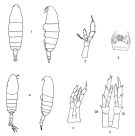 Female: 1, habitus (dorsal, lateral); 2, P5; Issued from : Brodsky K.A. in Calanoida of the Far Eastern seas and polar basin of the USSR (Israel Program scient. Trans., 1967, 1-440 ). 3, genital segment; Issued from : Brodsky K.A. in Issled. Fauny Morei, 1972, 12 (20): 5-110. Male: 4, habitus (dorsal, lateral; 5, P5; issued from Brodsky, 1967. 6, P5 (G: left, Dt: right); issued from : Brodsky, 1972. As .
|
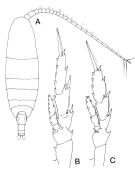 issued from : J.M. Bradford-Grieve in The Marine Fauna of New Zealand: Pelagic Calanoid Copepoda. National Institute of Water and Atmospheric Research (NIWA). New Zealand Oceanographic Institute Memoir, 102, 1994. [p.43, Fig.17]. Female: A, habitus (dorsal); B, P2; C, P5.
|
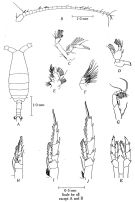 issued from : J.B. Jillett in Aust. J. Freshwat. Res., 1968, 19. [p.28, Fig.3]. As Calanus tonsus. Male (from Otago Peninsula, SE New Zealand):A, habitus (dorsal); B, A1; C, A2; D, Md; E, Mx1; F, Mx2; G, Mxp; H, P1; I, P2; J, P3; K, P5. Nota: Urosome length about 1/4 of the total body length. - Head and 5 thoracic segments. - The 4th thoracic segment bears a small pair of dorso-lateral spines. - Postero-lateral corners of the 5th thoracic segment broadly rounded (when viewed laterally). - Rostrum with 2 slender filaments. - Urosome is 5-segmented, having the proportional lengths as 17 : 36 : 21 : 13 = 100. - The furcal rami are about 1.5 times as long as broad, and are strongly divergent. - A1 25-segmented, distinctly separate from one another; reaches just beyond the end of the caudal rami; proportional lengths of segments 98 : 30 :38 : 34 : 38 ; 38 : 30 : 27 : 34 : 42 : 45 : 45 : 45 : 45 : 45 : 49 : 45 : 45 : 38 : 38 : 34 : 30 : 27 : 15 = 1000. All segments bear setae on their anterior border, on e on the 2nd segment being particularly large. - P1 with a small blunt projection on the posterior face of the basal segment of exopodite (this projection is also present in the females but appears yo have been overlooked by other workers). - P2 with a recurved hook just inside the distal outer corner of the basal exopodite segment (this hook was figured for the female by Tanaka (1986) but not by Vervoort (1957). - P2-P4 with a row of short spines on the inner distal posterior corner of the 2nd basal segment (there are also present on the P5 of the female, but not in the male). Usually there are 3 but sometimes 4 spines in this row and in some specimns the number differ on each leg in the same pair. - P5 are modified by comparison with those of the female but are very similar to those of the male of C. plumchrus (= Neocalanus plumchtus). The 2nd and 3rd exopodite segments both lack setae on their inner margins. The left exopodiyr differs from the right in having a larger basal segment, the inner margin of all three segments is finely setose, and the terminal segment bears much smaller spines and has a concave inner margin.
|
 issued from : J.M. Bradford in N.Z. Jl Mar. Freshw. Res., 1970, 4 (4). [p.352, Fig. 2]. As Calanus tonsus. Male (off Kaikoura, New Zealand): 2, P5 Scale bar represents 0.1 mm.
|
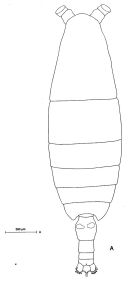 Issued from: M.G. Mazzocchi, G. Zagami, A. Ianora, L. Guglielmo & J. Hure in Atlas of Marine Zooplankton Straits of Magellan. Copepods. L. Guglielmo & A. Ianora (Eds.), 1995. [p.106, Fig.3.15.1]. Female: A, habitus (dorsal). Nota: Proportional lengths of urosomites and furca 42:22:11:11:14 = 100.Basipod of P5 with smooth inner margins without teeth; basipod 2 with 4 spines on distal inner surface.
|
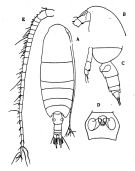 issued from : O. Tanaka in J. oceanogr. Soc. Japan, 1956, 12 (2). [p.49, Fig.1]. Female (from subantarctic Indian Ocean): A, habitus (dorsal); B, forehead (lateral); C, 5 th thoracic segment and urosome (lateral left side); D, genital segment (ventral); E, right A1. Nota: Cephalothorx and urosome in the proportional lengths 128:35. Head and 1st thoracic segment separate, 4th and 5th separate. Rostrum with 2 slender filaments. Proportional lengths of urosomites and furca 40:26:11:3:20 = 100.Genital segment laterally produced, about as long as wide in dorsal aspect (14:15). Genital opening produced slightly below, genital flap rather small. Furcal rami 1.5 times as long as wide. A1 (25-segmented)extends about to the distal end of the anal segment.
|
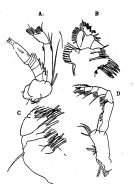 issued from : O. Tanaka in J. oceanogr. Soc. Japan, 1956, 12 (2). [p.50, Fig.2]. Female: A, A2; B, Mx1; C, Mx2; D, Mxp. Nota: Endopod of A2 slightly longer than exopod (47:44); inner marginal setae on 1st and 2nd exopodal segments not feeble; 2nd exopodal segment with 6 + 1 setae on the external lobe. Mx1 with a small 1st inner lobe furnished with 10 strong and 4 slender spines; 2nd and 3rd lobe with each 4 setae, 1st outer lobe with 9 setae; exopod with 11 setae; 2nd basal segment with 4 setae; 1st endopodal segment with 4, 3rd with 7 setae. mx2 with a plumose seta on the outer margin of the 1st basal segment.
|
 issued from : O. Tanaka in J. oceanogr. Soc. Japan, 1956, 12 (2). [p.51, Fig.3]. Female: A, Md (mandibular palp); B, Md (masticatory edge); C, right P1 (posterior); D, right P2; E, right P3.
|
 issued from : O. Tanaka in J. oceanogr. Soc. Japan, 1956, 12 (2). [p.51, Fig.4, A]. Female: A, right P5 (posterior). Nota: Inner distal corner of 2nd basal segment with 3 spines on the right leg, and 4 on le left leg; the short spines appear to be variable in number; they varied from 2 to 4 in the specimens observed (Wolfenden's specimen had 5 spines on the 2nd basal segment of right leg).
|
 issued from : W. Vervoort in B.A.N.Z. Antarct. Res. Exped., Rep.-Ser. B, III, 1957. [Fig.3]. As Calanus tonsus. Female from 44°05'S, 147°35'E): a-b, habitus (lateral and dorsal, respectively); c, left A1; d, left Md (cutting edge).
|
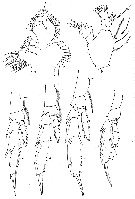 issued from : W. Vervoort in B.A.N.Z. Antarct. Res. Exped., Rep.-Ser. B, III, 1957. [Fig.4]. As Calanus tonsus. Female: a, left Mx1; b, left Md (mandibular palp); c-f, P2 to P5 (posterior aspect). Nota: Mx1 differs from that of Calanus propinquus by the presence of 5 (instead of 4) setae on the 3rd inner lobe.The P5 differs from that of C. propinquus by the total absence of spinules along the internal border of the 1st basal segment: moreover, there are 2 setae along the external border of the 3rd endopodal segment (only 1 in C. propinquus.
|
 issued from : W. Vervoort in B.A.N.Z. Antarct. Res. Exped., Rep.-Ser. B, III, 1957. [Figs.5-6]. As Calanus tonsus. Female: 5 (above): a, left A2; b, left Mx2; c, Mxp.; 6 (below): a, c, posterior part cephalothorax and urosome (dorsal and lateral, rescetively); b, left P1 (anterior aspect). Nota: The seta on the ventral border of Mx2 is delicate and may easily be overlooked.
|
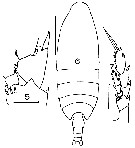 issued from : J.M. Bradford in Mem. N. Z. Oceonogr. Inst., 1972, 54. [p.33, Fig.4 (5-7)]. As Calanus tonsus. Female (from Kaikoura, New Zealand): 5, P2 (basipod and part exopod, endopod segments 1); 6, habitus (dorsal); 7, P5. Scale bars: 1 mm (6); 0.1 mm (5, 7). Nota: The 1st exopod segment of the female P2 is similar in form to that of Neocalanus.
|
 issued from : R.J. Machida, M.U. Miya, M. Nishida & S. Nishida in Mar. Biol., 2006, 148. [p.1077, Table 5]. Comparisons of selected biological characteristics of 6 species olus 1 subspecies of Neocalanus.
|
 issued from : N.V. Vyshkvartzeva in Issled. Fauny Moreï, 1972, 12 (20). [p.168, Fig.7, 3a, 3b, 3g). As calanus tonsus. Female stage V: 3a, Md (masticatory edge, lateral view); 3b, left Md (above view); 3g, right Md (above view).
|
 issued from : A. Fleminger in Mar. Biol., 1985, 88. [p.283, Fig.5 D]. As Calanus s.l. tonsus.
Male (from S Pacific, subtropical): Left A1 proximal segments (ventral view);
Nota: see remarks in Calanus s.l. pacificus californicus (Fleminger, 1985, p.275) concerning the dimorphism in the female A1.
|
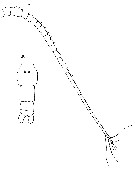 Issued from : G.S. Brady in Rep. Scient. Results Voy. Challenger, Zool., 1883, 8 (23). [Pl. IV, Figs.8, 9]. As Calanus tonsus. Female: 8, A1; 9, urosome.
|
 Issued from : V.N. Andronov in Russian Acad. Sci. P.P. Shirshov Inst. Oceanol. Atlantic Branch, Kaliningrad, 2014. [p.73, Fig.19, 2]. As Calanus tonsus after Brodsky, 1964 . Male P5
|
 Issued from : C. Razouls in Ann. Inst. océanogr., Paris, 1994, 70 (1). [p.33]. Caractéristiques morphologiques de Neocalanus tonsus femelle et mâle adultes. Terminologie et abbréviations: voir à Calanus propinquus.
| | | | | Ref. compl.: | | | Ohman, 1987 (p.1317, feeding, egg production); Ohman & al., 1989 (p.1309, lipids); Heinrich, 1995 (tab.1); Atkinson, 1996 (p.85, feeding); Atkinson & al., 1996 (p.1387, diel periodicity, feeding); Mauchline, 1998 (tab.21, 22, 46, 64); Bradford-Grieve & Jillett, 1998 (p.65, Southern distribution); Stephen, 1998 (p.341, 342, chart); Onishchik, 1999 (p.76, figs.2, 5); Atkinson & Sinclair, 2000 (p.46, fig.2, 3, Table 4, 5, zonal distribution); Razouls & al., 2000 (p.343, tab. 5, Appendix); Ward & al., 2003 (p.121, tab.4); Hunt, 2004 (p.1, 74, Table 4.7); ? Ashjian & al., 2005 (p.1380: tab.2, as tonsa); Berasategui al., 2005 (p.313, fig.2); Hunt & Hosie, 2006 (p.1203, tab.2, fig.8); Park & Ferrari, 2009 (p.143, Table 2, fig.2, Appendix 1, biogeography); Takahashi & al., 2010 (p.317, Table 3, 4); Takahashi & al., 2011 (p.134, distribution); Fierro Gonzalvez, 2014 (p.1, Tab. 3, 5, occurrence, abundance); Acha & al., 2020 (p.1, Table 3: occurrence % vs ecoregions, Table 5: indicator ecoregions). | | | | NZ: | 13 | | |
|
Carte de distribution de Neocalanus tonsus par zones géographiques
|
| | | | | | | | |  issued from : R.J. Machida, M.U. Miya, M. Nishida & S. Nishida in Mar. Biol., 2006, 148. [p.1077, Fig.4]. issued from : R.J. Machida, M.U. Miya, M. Nishida & S. Nishida in Mar. Biol., 2006, 148. [p.1077, Fig.4].
Relationship between the phylogeny and distribution pattern of the Neocalanus species.
Shaded portions of the maps represent distributions based on the litterature. Clades A-E correspond to those in Fig.3, p.1075. |
 issued from : R. Stephen in Pelagic Biogeography ICoPB II. Proc. 2nd Int. Conf. Final report of SCOR/IOC working group 93. 9-14 July 1995. Workshop Rep. No.142. UNESCO, 1998. issued from : R. Stephen in Pelagic Biogeography ICoPB II. Proc. 2nd Int. Conf. Final report of SCOR/IOC working group 93. 9-14 July 1995. Workshop Rep. No.142. UNESCO, 1998.
Fig.5: Distribution of Neocalanus gracilis and Neocalanus tonsus in the Indian Ocean.
P.341, Fig.5: Distribution of Neocalanus gracilis and Neocalanus tonsus in the Indian Ocean.
|
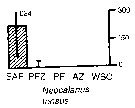 Issued from : A. Atkinson & J.D. Sinclair in Polar Biol., 2000, 23. [p.50, Fig.3] Issued from : A. Atkinson & J.D. Sinclair in Polar Biol., 2000, 23. [p.50, Fig.3]
Neocalanus tonsus from Scotia Sea.
Median and interquartile ranges of copepods (nos /m2) in the five water zones; from north to south these are SAF Subantractic Front area, PFZ Polar frontal Zone, PF Polar Front area, AZ Antarctic Zone, WSC Weddell-Scotia Confluence area/ East Wind Drift.
Numbers on the plots are upper interquartiles where these could not be scaled. |
 Issued from : E.T. Park & F.D. Ferrari in A selection from Smithsonian at the Poles Contributions to International Polar year. I. Krupnik, M.A. Lang and S.E. Miller, eds., Publs. by Smithsonian Institution Scholarly Press, Washington DC., 2009. [p.167, Fig.2]. Issued from : E.T. Park & F.D. Ferrari in A selection from Smithsonian at the Poles Contributions to International Polar year. I. Krupnik, M.A. Lang and S.E. Miller, eds., Publs. by Smithsonian Institution Scholarly Press, Washington DC., 2009. [p.167, Fig.2].
Distribution of selected pelagic calanoids Neocalanus tonsus of the Southern Ocean and the closest relative in the subarctic region of the Arctic Ocean. |
 Issued from : H. Saito & A. Tsuda in Deep-Sea Res. I, 47. [p.2146, Table I]. Issued from : H. Saito & A. Tsuda in Deep-Sea Res. I, 47. [p.2146, Table I].
Egg diameter and prosome length (PL) of females of Neocalanus tonsus afrter Ohman, 1987
Nota: Compare with N. cristatus, N. flemingeri and and N. plumchrus, and others species in genus Calanus. |
| | | | Loc: | | | Antarct. (Indian, SW Pacif., Mc Murdo), sub-Antarct. (South Georgia, Scotia Sea, Indian, SW & SE Pacif.), Agulhas Bank, S & E), South Africa (S), Tristan da Cunha, SW Atlant., G. of Guinea, Argentina (off shore N-S, off Patagonia), off Woods Hole, Indian (Natal, Madagascar, equatorial), Australia (W, SW, SE, Tasmania), Philippines, New Zealand (Otago Peninsula, Kaikoura, SE North Island), off E New Zealand, S Pacif. (NPFZ), Chile (N & S), Straits of Magellan (Pacific & Central area); [ Japan Sea, Okhotsk Sea, SW Bering Is., Alutian, Charlotte Queen Is., Strait of Georgia, Bikini Is. ] | | | | N: | 69 | | | | Lg.: | | | (25) F: 4,05-3,69; (32) F: 3,6-3,5; (35) F: 3,6-3,48; (36) F: 3,92; (47) F: 3,6; (114) F: 4,6-4,35; M: 3,1; (116) F: 4,1-3,8; (124) F: 4,24-4,07; 3,75-3,66; (196) F: 4-3,3; M: 3,9-3,3; (231) M: 3,45-3,25; (313) M: 3,45-3,25; (331) M: 4,4-4,1; {F: 3,30-4,60; M: 3,10-4,40} | | | | Rem.: | Sampling depth (Antarct., sub-Antarct.) : 0-500 m.
Une confusion a existé entre Calanus tonsus et Calanus plumchrus .
Il ne sera pas tenu compte des localisations de cette espèce dans le Nord Pacifique dans la matrice, dont les références sous l'ancienne dénomination de Calanus tonsus sont entre crochets.
Pour Ohman (1987, p.1326) les differences observées concernant les appendices buccaux entre N. tonsus (principalement dans l'hémisphère sud) d'une part, et les espèces congénères N. plumchrus et N. cristatus (principalement dans l'hémisphère nord) d'autre part, montrent que l'on ne peut inférer du régime alimentaire des females adultes. De ce fait on ne peut extrapoler d'un régime alimentaire commun pour les espèces d'un même genre. L'examen de la morphologie des appendices buccaux comme de l'expérimentation s'avèrent nécessaire pour les divers stades copépodites.
Voir aussi les remarques en anglais | | | Dernière mise à jour : 03/04/2020 | |
|
|
 Toute utilisation de ce site pour une publication sera mentionnée avec la référence suivante : Toute utilisation de ce site pour une publication sera mentionnée avec la référence suivante :
Razouls C., Desreumaux N., Kouwenberg J. et de Bovée F., 2005-2025. - Biodiversité des Copépodes planctoniques marins (morphologie, répartition géographique et données biologiques). Sorbonne Université, CNRS. Disponible sur http://copepodes.obs-banyuls.fr [Accédé le 28 décembre 2025] © copyright 2005-2025 Sorbonne Université, CNRS
|
|
 |
 |






















